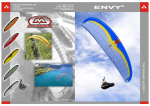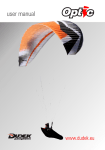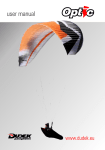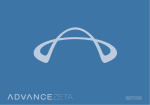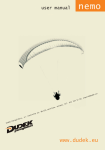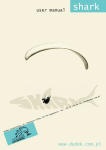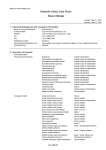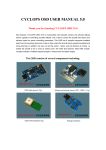Download 4. NORMAL PROCEDURES
Transcript
CAP 10C 4. NORMAL PROCEDURES 4.1 Presentation................................................................ 4-3 4.2 Speeds......................................................................... 4-3 4.3 Check-list of normal procedures ............................... 4-4 4.4 Spins............................................................................ 4-15 Original issue: 31 January 2002 Revision: 0 Document: 1000809 GB Page 4-1 NORMAL PROCEDURES CAP 10C Original issue: 31 January 2002 Revision: 0 Document: 1000809 GB Page 4-2 NORMAL PROCEDURES CAP 10C 4. NORMAL PROCEDURES 4.1 PRESENTATION This section describes the procedures for normal operation. NOTE Normal procedures associated with optional systems are in section 9. Supplements. 4.2 SPEEDS Takeoff: .................................................. 110 km/h (59 kt) Normal climb: ......................................... 160 km/h (86 kt) Best climb angle (Vx):............................. 130 km/h (70 kt) (cat. U) 120 km/h (65 kt) (cat. A) Optimum climb (Vy) allowing for Best climb rate (Vz max.):....................... 150 km/h (81 kt) 15° flap 160 km/h (86 kt) clean config. Descent: ................................................. 200 km/h (108 kt) Approach: ............................................... 150 km/h (81 kt) 15° flap 120 km/h (65 kt) Full flaps Recommended speed for turbulence penetration:...................... 200 km/h (108 kt) Maximum demonstrated crosswind: ...... 37 km/h (20 kt) Original issue: 31 January 2002 Revision: 0 Document: 1000809 GB Page 4-3 NORMAL PROCEDURES CAP 10C 4.3 CHECK-LIST OF NORM AL PROCEDURES 4.3.1 Pre-flight inspection Cockpit Make certain cockpit is clean. Master switch.......................................... OFF Alternator switch ..................................... OFF Magnetos................................................ OFF Fuel selector switch ................................ OPEN, FWD TANK CAUTION For aerobatics, the rear tank must be empty and the ELT must be removed. Flight controls ......................................... FREE, in CORRECT DIRECTION Engine controls....................................... FREE Battery contact........................................ ON Stall warning indicator............................. CHECKED Warning lights......................................... CHECKED Fuel gauges............................................ CHECKED Battery contact........................................ OFF Seat belts and harnesses ....................... CHECKED Canopy attachment................................. CHECKED Release handle....................................... CHECKED Before getting down from aircraft Fuel tank................................................. visual inspection Fuel cap.................................................. closed and locked Original issue: 31 January 2002 Revision: 0 Document: 1000809 GB Page 4-4 NORMAL PROCEDURES CAP 10C Left wing Flap ........................................................ hinges and control Aileron .................................................... hinges and control Balance plates and deflection Pitot ........................................................ clean, not clogged Main landing gear ................................... shock absorber checked and tyre inflated Underwing inspection door ..................... locked Fwd fuselage Tank drain .............................................. checked Exhaust .................................................. checked Lower inspection door ............................ closed and locked Cowl left door ......................................... closed and locked Propeller ................................................. condition and attachment Spinner ................................................... condition and attachment Air inlet ................................................... free Oil level................................................... checked (6 qt maximum for aerobatics) Cowl right door ....................................... closed and locked Right wing Main landing gear ................................... shock absorber checked and tyre inflated Underwing inspection door ..................... locked Original issue: 31 January 2002 Revision: 0 Document: 1000809 GB Page 4-5 NORMAL PROCEDURES CAP 10C Aileron .................................................... hinges and control Balance plates and deflection Flap ........................................................ hinges and control Rear right fuselage Static port................................................ clean and not clogged Antennas ................................................ VISUAL INSPECTION Door........................................................ locked Horizontal stabiliser Horizontal stabiliser ................................ ATTACHMENT Elevator and vertical stabiliser ................ hinges and control Deflection and cable tension Rudder tab.............................................. hinges and control Elevator tab ............................................ hinges and control Tail wheel Tail wheel rubber .................................... Good condition Conjugation springs ................................ Condition and operation Aft left fuselage Static port ............................................... CLEAN, NOT CLOGGED Tank drains (qty: 2)................................. CHECKED Inspection door under fuselage............... Closed and locked Tank cap................................................. CLOSED and LOCKED Original issue: 31 January 2002 Revision: 0 Document: 1000809 GB Page 4-6 NORMAL PROCEDURES CAP 10C 4.3.2 Before starting-up Parking brake ......................................... ON Seats ...................................................... ADJUSTED and LOCKED Pilot and passenger seat belts................ ATTACHED Master switch ......................................... OFF Alternator switch ..................................... OFF Magnetos................................................ OFF Electrical equipment ............................... OFF Flaps/trim switch (as appropriate)........... ON Avionics switch (as appropriate) ............. ON Mixture ................................................... LEAN Cockpit heating....................................... CLOSED 4.3.3 Starting up cold engine Master switch ......................................... ON Flaps ...................................................... RETRACTED - CHECKED Anti-collision light.................................... ON Throttle lever .......................................... PUSHED (FULL THROTTLE) Mixture ................................................... FULL RICH Tank selector switch ............................... FWD Electric pump.......................................... ON Fuel flow meter ....................................... CHECKED Electric pump.......................................... STOP Throttle lever .......................................... 1 cm Mixture ................................................... LEAN Magnetos................................................ 1 + 2 Starter .................................................... on request Original issue: 31 January 2002 Revision: 0 Document: 1000809 GB Page 4-7 NORMAL PROCEDURES CAP 10C Mixture.................................................... RICH as soon as engine is running Throttle lever........................................... set for 1 000 rpm 4.3.4 Starting up hot engine Master switch.......................................... ON Anti-collision light (as appropriate) .......... ON Throttle lever........................................... 4 to 5 cm Mixture.................................................... LEAN Magnetos................................................ 1 + 2 Starter..................................................... on request Mixture.................................................... RICH as soon as engine is running Throttle lever........................................... set for 1 000 rpm 4.3.5 Engine heating Engine speed.......................................... 1 000 to 2 000 rpm NOTE Do not exceed 1 000 rpm for the first minute. Oil pressure ............................................ CHECKED (4 to 6 bars) NOTE If the oil pressure did not rise to above 1.8 bar within 30 seconds after startup, stop the engine and proceed with verification. Fuel pressure.......................................... CHECKED Cut-off test (magnetos) ........................... DONE Alternator switch ..................................... ON Original issue: 31 January 2002 Revision: 0 Document: 1000809 GB Page 4-8 NORMAL PROCEDURES CAP 10C Battery charge ........................................ CHECKED Electrical equipment ............................... ON Rear tank test ......................................... 5 min (if use intended) NOTE Takeoff is authorised when the oil temperature reaches the green zone. 4.3.6 Taxiing Parking brake ......................................... RELEASED Brakes and conjugation test ................... DONE NOTE When starting off, make certain the tail wheel conjugation is operative by checking that the aircraft responds correctly to rudder pedal movements. 4.3.7 Run-up Brakes .................................................... APPLIED (use the pedals) Temperatures and pressures.................. CHECKED Mixture ................................................... FULL RICH Magnetos check at 1 800 rpm................. 1, then 1 + 2 2, then 1 + 2 NOTE Permitted engine drop: 125 rpm per magneto. Maximum difference between magnetos: 50 rpm. Idle ......................................................... test Magnetos................................................ cut-off test Mixture ................................................... LEAN then RICH Original issue: 31 January 2002 Revision: 0 Document: 1000809 GB Page 4-9 NORMAL PROCEDURES CAP 10C 4.3.8 Vital actions before takeoff Engine Tank selector switch ............................... FWD Autonomy ............................................... CHECKED Mixture.................................................... SET MAX POWER Master switch.......................................... ON Alternator switch ..................................... ON Battery charge ........................................ CHECKED Magnetos................................................ 1 + 2 Flight controls Elevator .................................................. free in correct direction Lateral control......................................... free in correct direction Rudder pedals ........................................ free in correct direction Elevator tab ............................................ CHECKED then NEUTRAL Flaps....................................................... FULL FLAPS then 15° Equipment Mechanical accelerometer ...................... reset Altimeter ................................................. SET VHF ........................................................ SET Cockpit Canopy ................................................... Closed and locked Seat belt and harnesses ......................... ATTACHED Brakes .................................................... RELEASED Original issue: 31 January 2002 Revision: 0 Document: 1000809 GB Page 4-10 NORMAL PROCEDURES CAP 10C 4.3.9 Takeoff Throttle lever .......................................... FULL THROTTLE Maximum engine speed.......................... CHECKED 2 250 ± 50 rpm Tail up .................................................... from 50 km/h (27 kt) Takeoff speed......................................... 110 km/h (59 kt) NOTE Propeller torque is to the left on this aircraft. Engine speed ......................................... check 2300 rpm ± 50rpm Initial climb.............................................. 140 km/h (76 kt) Flaps ...................................................... RETRACTED (91 m - 300 ft) Normal climb .......................................... 160 km/h (86 kt) clean config. 4.3.10 Climb speed Best climb angle (Vx).............................. 130 km/h (70 kt) (cat. U) 120 km/h (65 kt) (cat. A) Optimum climb (Vy) allowing for Best climb rate (Vz max.)........................ 160 km/h (86 kt) clean config. NOTE To obtain the best rate of climb (Vz max.), keep full power and check the engine speed for 2 350 rpm, retract flaps, check pressures and temperatures. Original issue: 31 January 2002 Revision: 0 Document: 1000809 GB Page 4-11 NORMAL PROCEDURES CAP 10C 4.3.11 Cruise In cruising flight, you are advised to use the mixture control at all altitudes. Consumption is then reduced and can be diminished by about 15 %. The maximum continuous engine speed of 2 700 rpm must in no event be exceeded. To obtain the best mixture, slowly reduce the mixture going from the full rich position until you obtain maximum power: in the case of a fixed pitch propeller, gradually reduce the mixture until the tachometer shows start of engine speed loss. If the aircraft is equipped with an EGT indicator, this point represents the maximum temperature. We advise enriching the mixture until the temperature is 50°F (generally 2 graduations) below the maximum observed temperature. Where there is no EGT, we advise you to enrich the mixture by rotating the mixture knob over two complete turns. REMARK Also see the Engine User's Manual. 4.3.12 Descent Mixture.................................................... FULL RICH Tank ....................................................... THE FULLEST Engine speed.......................................... 1 700 to 1 800 rpm Recommended speed............................. 200 km/h (108 kt) Pitot heat ................................................ according to weather conditions 4.3.13 Approach Speed flaps 15 ° ..................................... 150 km/h (81 kt) Speed flaps 40 ° ..................................... 120 km/h (65 kt) Original issue: 31 January 2002 Revision: 0 Document: 1000809 GB Page 4-12 NORMAL PROCEDURES CAP 10C 4.3.14 Interrupted landing Go-around Configuration .......................................... FULL THROTTLE – Full flaps Best rate of climb speed (Vy).................. 135 km/h (73 kt) Flaps ...................................................... 15° NOTE To obtain the best rate of climb (Vz max.), keep full power and check the engine speed for 2 350 rpm, retract flaps, adjust speed for best rate of climb, i.e. 160 km/h (86 kt) and check pressures and temperatures. NOTE In category A, these performance levels are improved in relation to reduction in weight. 4.3.15 Engine shut-down Parking brake ......................................... ON NOTE If brakes are used intensively during landing and taxiing up to the parking area, do not apply the parking brake before the wheels have cooled down; use chocks. Electrical equipment ............................... OFF Cut-off test (1 000 rpm)........................... DONE then 1 + 2 REMARK For a short taxiing period before shut-down, let the engine run for 1 (one) minute at 1 100 rpm. Engine speed ......................................... 1 100 rpm Original issue: 31 January 2002 Revision: 0 Document: 1000809 GB Page 4-13 NORMAL PROCEDURES CAP 10C Oil pressure ............................................ CHECKED Mixture.................................................... LEAN Magnetos................................................ OFF Alternator switch ..................................... OFF Anti-collision ........................................... OFF Flaps....................................................... EXTENDED Master switch.......................................... OFF Tank selector switch ............................... CLOSED 4.3.16 Manoeuvres For any aerobatics manoeuvre: • the overall weight of the aircraft must be less than 780 kg (1 720 lb) ; • centre of gravity must be forward of 26 %; • aft tank must be empty (use fwd tank). Minimum recommended speeds when beginning trick Single-seater Manoeuvres km/h kt Loop 220 119 Split S 210 113 Slow roll 220 119 Snap manoeuvre 140 76 Inverted loop 250 135 Wingover 200 108 Two-seater km/h kt 230 124 220 119 230 124 140 76 270 146 200 108 Caution Electrical flaps system switched off in category A. A/C equipped with an electrical tab: switch system off in category A. Original issue: 31 January 2002 Revision: 0 Document: 1000809 GB Page 4-14 NORMAL PROCEDURES CAP 10C 4.3.17 Stalls You can perform stalls with or without engine in all permitted weight and C.G. configurations. Generally, stalling is not preceded by warning signs. Only the indicator light comes on in a positive stall. In negative flight, stalls must always happen in clean configuration. 4.3.18 ELT The emergency beacon must be removed by the pilot or a mechanic before any aerobatic flight. 4.4 SPINS Spinning on CAP10 is authorised with engine on idle in category A. The loss of altitude is about 400 feet per rotation, i.e. 120 metres. Each spin rotation takes about 2 seconds. 4.4.1 Instructions for recovery from positive or negative spin Positive spin Rudder ................................................... full opposite rudder (opposite to direction of rotation) Elevator .................................................. nose-up sector Lateral control......................................... roll towards spin Original issue: 31 January 2002 Revision: 0 Document: 1000809 GB Page 4-15 NORMAL PROCEDURES CAP 10C Negative spin Rudder.................................................... full opposite rudder (opposite to direction of rotation) Elevator .................................................. nose-up sector Lateral control......................................... neutral If the rudder, elevators or ailerons are not kept in the position indicated above, recovery still remains possible but will tend to take more time. In all events you must: BE SURE TO KEEP DIRECTION OF RUDDER FULL OPPOSITE TO DIRECTION OF ROTATION 4.4.2 Influence of centre of gravity CAUTION Mainly by acting on the aircraft's attitude, the centre of gravity has tremendous influence on CAP10's behaviour in spin. Aft C.G. (24 to 26%) Flat attitude, about 50°, indicated airspeeds of about 150 km/h, tendency to level out more to left than to right. Fwd C.G (22 to 20%) Dive attitude up to 70° indicated airspeed being capable of exceeding 180 km/h, tendency to dive more to right than to left. Risk of Va being exceeded during spin and recovery. Immediately apply instructions for recovery as soon as speed reaches 180 km/h. Original issue: 31 January 2002 Revision: 0 Document: 1000809 GB Page 4-16 NORMAL PROCEDURES CAP 10C 4.4.3 Influence of stick position CAUTION The stick position (roll control) has an influence on the CAP10's behaviour during spin. Stick to counter spin For example, in left spin, the stick to the right tends to level spin out and, as a result, reduce the indicated airspeed. CAUTION In the case of spin with centre of gravity aft, this manoeuvre may prove to be dangerous by exacerbating the tendency to level out and delaying the recovery time. Stick in direction of spin For example, in left spin, the stick to the left tends to agitate and/or deepen the spin and, as a result, increase the indicated airspeed. CAUTION Whatever the centre of gravity, this manoeuvre may prove to be dangerous due to the increased risk of: • turbulent to very turbulent spin; • increase in speed; • transition to a flick roll. In all cases listed above, apply the instructions for recovery (see § 4.4.1). NOTE In the event of engine shut-down during spin, immediately apply the instructions for recovery from spin then apply the instructions for engine restart (SECTION 3). Original issue: 31 January 2002 Revision: 0 Document: 1000809 GB Page 4-17 NORMAL PROCEDURES CAP 10C Summary CAP10's behaviour in spin can be summarised as follows: Spin stick against direction of spin • calm • low speed • long recovery time Spin stick in direction of spin • turbulent to very turbulent • high speed and unstable • short recovery time Original issue: 31 January 2002 Revision: 0 Document: 1000809 GB Page 4-18 NORMAL PROCEDURES


















